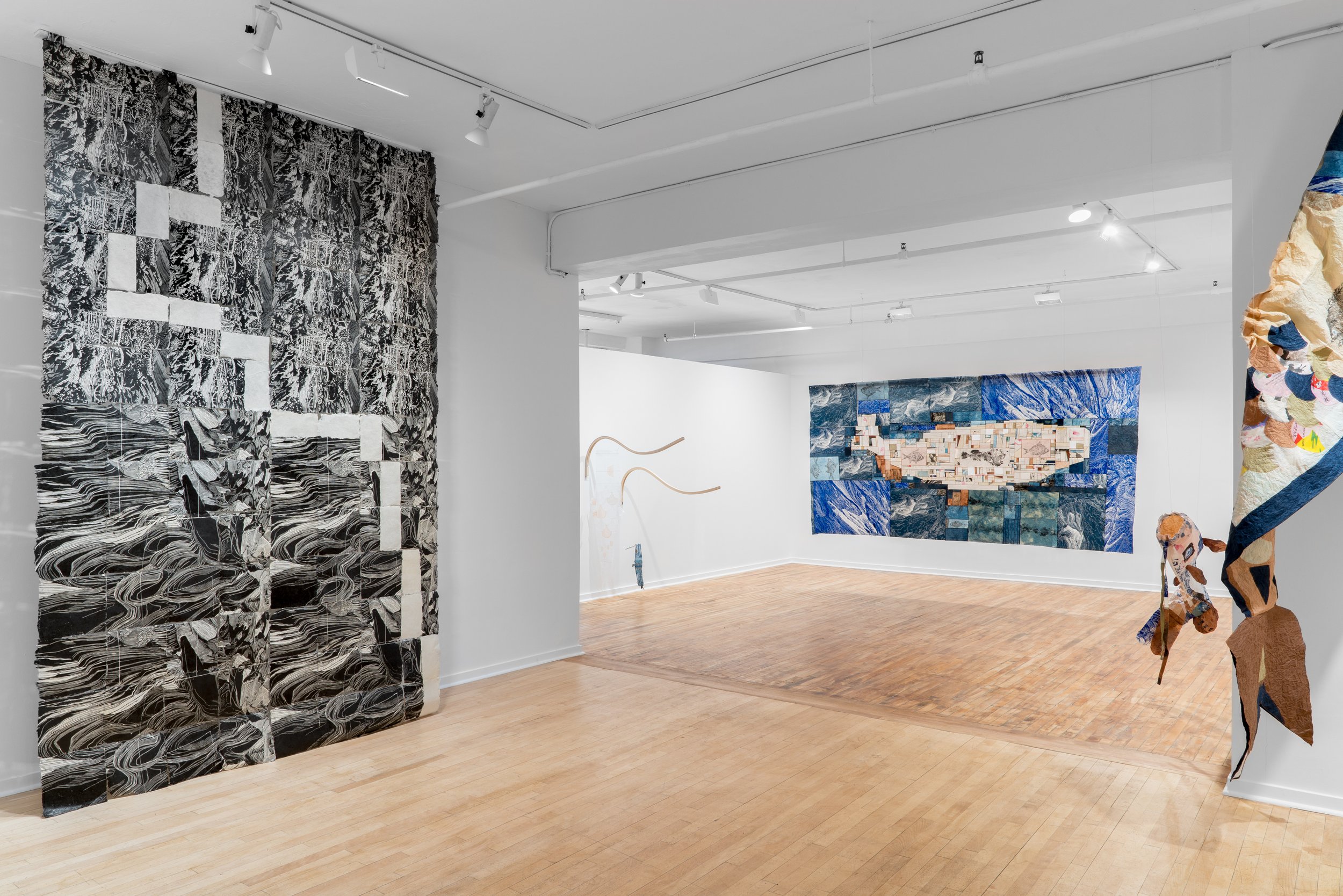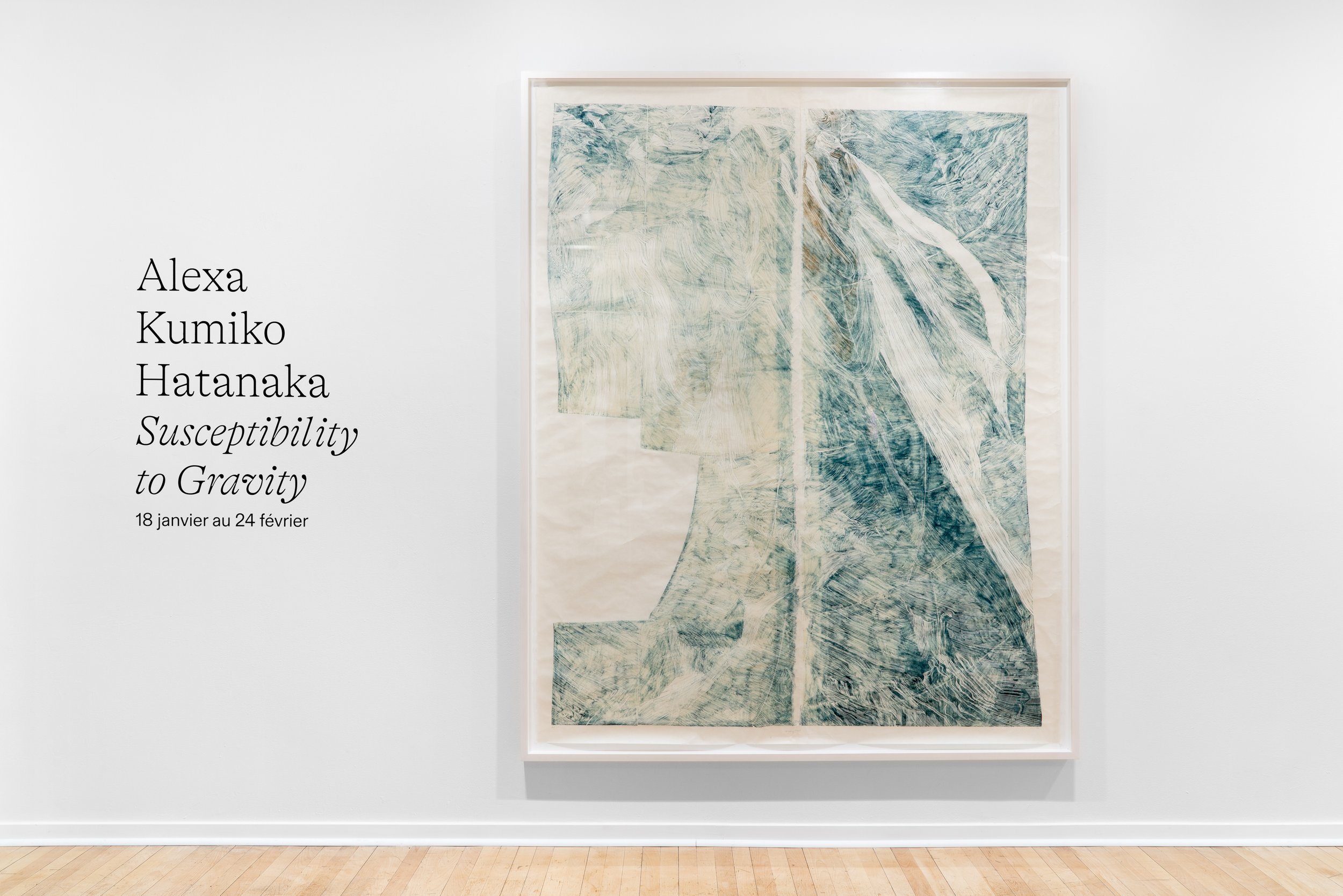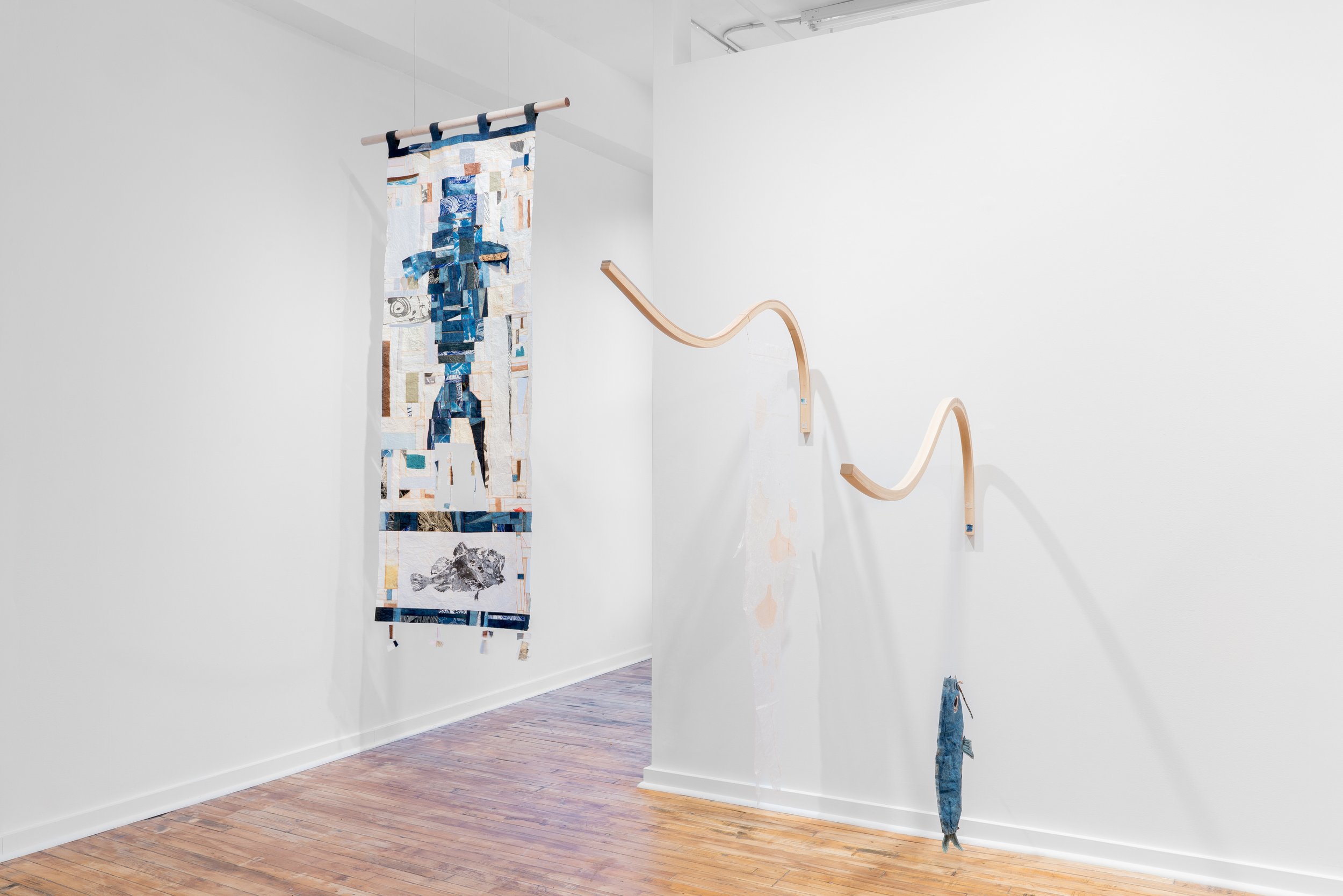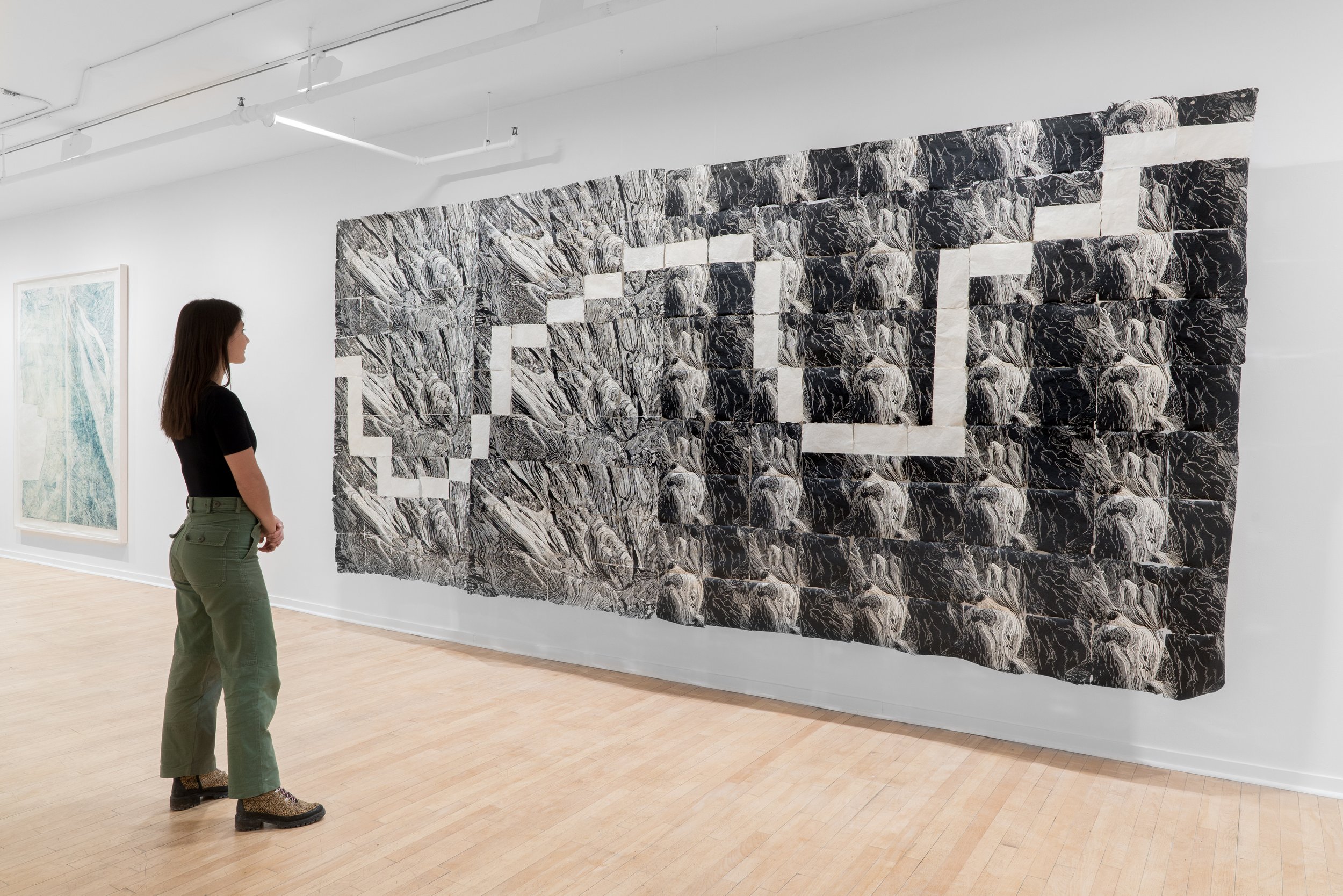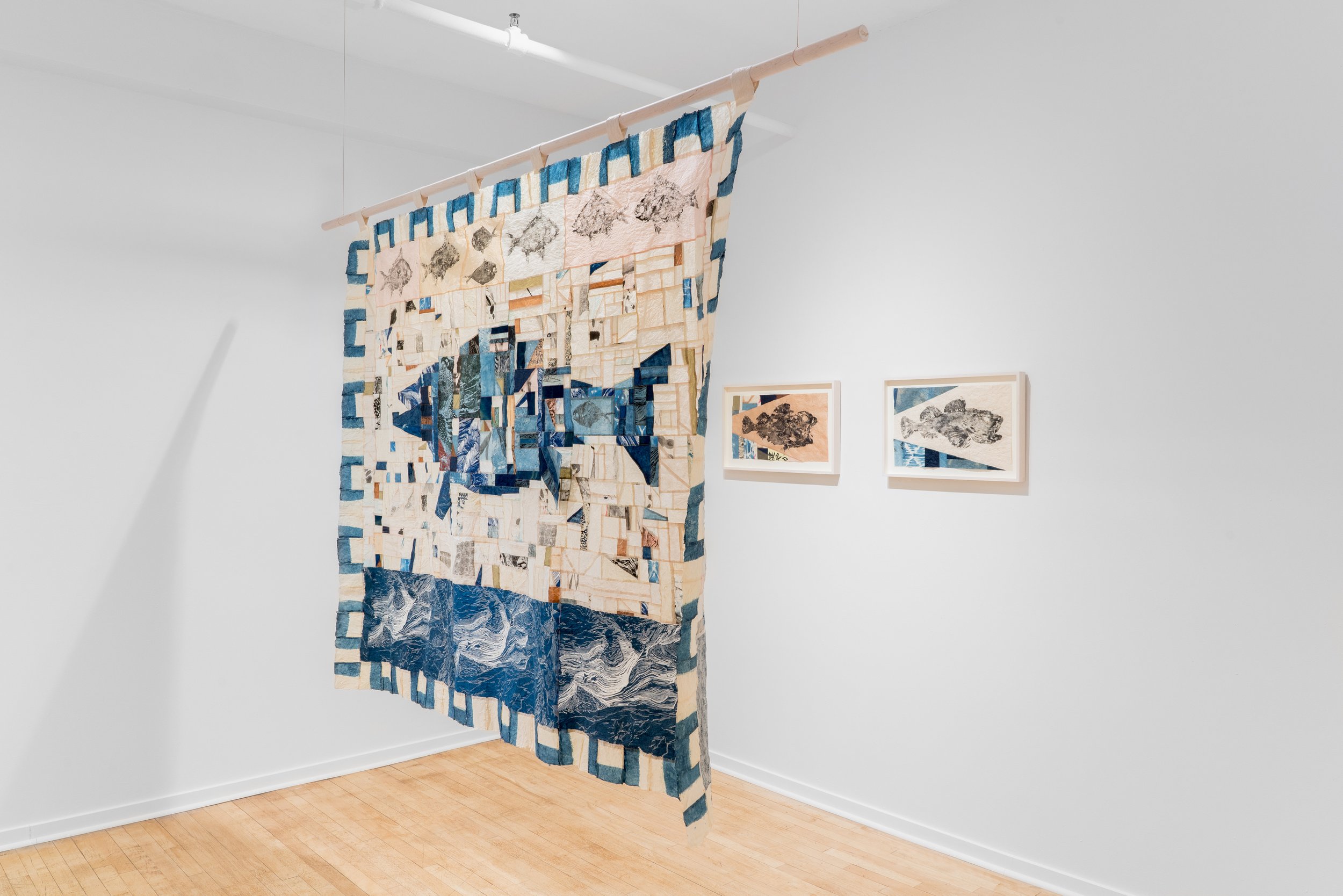372 rue Ste-Catherine O, #410, MOntréal
Alexa Kumiko Hatanaka | susceptibility to gravity | ....18 Jan - 24 FEB, 2024.. 18 Jan - 24 Fév 2024....
....
Alexa Kumiko Hatanaka intertwines motifs from her cultural heritage with conceptual and thematic elements from nature to create works that map out changes that move people, society, and the land. Her two- and three-dimensional work highlights the expressive quality of washi, a Japanese handcrafted paper that originated in the seventh century and is permeated with the characteristics of the people who make it, the specificities of the water that shapes it, and the history in which it is inscribed. Through ink printing techniques and the use of natural dyes such as kakishibu, a Japanese dye derived from persimmons, Hatanaka creates colourful compositions imbued with a sensitive relationship to nature. Notably, she makes paper clothes that is meant to be worn and is crafted according to the traditional process of kamiko, in which konnyaku starch is added to washi, softening the material enough for it to be sewn. Light and translucent, the paper appears fragile but is surprisingly strong.
Drawing on the natural events that have devasted Japan, particularly earthquakes and tsunamis, Hatanaka recounts the poetic story of the ties that bind human lives to the land, while taking a closer look at how these events are connected to her own personal history. Her work is imbued with considerations of the body and its search for well-being, expressed, notably, through explorations of her grandmother’s family’s immigration to Canada from Japan following the Great Kantō earthquake of September 1, 1923. These considerations are actualized through her use of traditional skills and her contribution to the collective efforts to preserve them, her systematic use of ecological and sustainable techniques and materials, and by the holistic approach that guides her practice. They also inform the title of her exhibition, inspired by an understanding of mental health in which a person’s state can be discerned based on their susceptibility to gravity: we feel heavier when we are unwell. Through her works, Hatanaka releases suffering that, while personal, may resonate with many.
Myths, anecdotes, and memories play an important role in Hatanaka’s work. Among these is the recurring motif of the fish, a reference to her great-grandfather’s trade as a fisherman, and her grandfather, who also practiced fishing. Additionally, it evokes the racism that pervaded the Canadian fisheries industry when the government confiscated 1,137 fishing boats from Japanese-Canadian fishermen after the attack on Pearl Harbor, and also the koinobori, carp-shaped windsocks that are commonly hoisted during various festivals. Inspired by the Japanese legend of a koi that reached the top of a waterfall after one hundred years of efforts, and was transformed into a golden dragon by the gods as a reward for its perseverance and determination, Hatanaka’s carp represents the spark of hope that lives on despite the weight of challenging events and circumstances. The fish motif also refers to another Japanese legend in which Namazu, the giant catfish that lives deep within an underground lair, causes earthquakes every time it moves.
Hatanaka’s polysemous works trace disruptions and tell stories of what persists, what feeds the heart and soul. Human bodies and waterways, stories and materiality, terrestrial movements, and migrations—the artist maps the interconnections that characterize selfhood: her own, in particular. Each of her works embodies, to a certain extent, a layer of herself, a stratum of her history.
Maude Johnson
..
Alexa Kumiko Hatanaka entrelace des motifs issus de son héritage culturel et des éléments conceptuels et thématiques se rapportant à la nature, dans des œuvres où elle cartographie des changements qui meuvent le soi, la société et le territoire. Dans son travail bidimensionnel et sculptural, elle met en lumière l’expressivité du washi, un papier artisanal japonais dont l’apparition remonte au 7e siècle et qui porte en lui le caractère des gens qui le fabriquent, les spécificités de l’eau qui lui donne forme, ainsi que l’histoire dans laquelle il s’inscrit. Grâce à des techniques d’impression à l’encre et à l’utilisation de teintures naturelles comme le kakishibu, une teinture japonaise réalisée à partir de kakis, l’artiste élabore des compositions colorées imprégnées d’une relation sensible à la nature. Elle crée notamment des vêtements de papier, destinés à être portés et conçus selon le procédé traditionnel kamiko, qui consiste à ajouter au washi un amidon de konnyaku permettant d’assouplir le matériau afin de le coudre. Léger et translucide, le papier d’apparence fragile fait preuve d’une étonnante solidité.
Puisant aux évènements naturels ayant remué le Japon, particulièrement les tremblements de terre et les tsunamis, Hatanaka trace le récit poétique des liens qui unissent les vies humaines au territoire, tout en se penchant plus intimement sur les connexions entre ces évènements et son histoire personnelle. Son travail est traversé de considérations envers le corps et sa recherche du bien-être, qui s’expriment entre autres dans son exploration de l’immigration, du Japon au Canada, de la famille de sa grand-mère à la suite du séisme du 1er septembre 1923. Ces considérations s’actualisent à travers l’attention qu’elle porte aux savoir-faire traditionnels et sa participation à l’effort collectif visant à les préserver, son utilisation systématique de techniques et matériaux écologiques et durables, ainsi que par l’approche holistique qui guide sa pratique. Elles teintent le titre de l’exposition, inspiré d’une vision de la santé mentale où l’état d’une personne peut être discerné à travers sa sensibilité à la gravité : nous sommes plus lourd·e lorsque nous n’allons pas bien. À travers ses œuvres, Hatanaka délie des douleurs qui, bien que personnelles, peuvent résonner auprès de plusieurs.
Les mythes, les anecdotes et les souvenirs occupent une place importante dans le travail de l’artiste. Faisant référence à la pêche, métier de son arrière-grand-père et activité pratiquée par son grand-père, le poisson est un motif récurrent dans ses œuvres. Il évoque le racisme qui a marqué l’industrie de la pêche canadienne, avec la confiscation par le gouvernement fédéral de 1137 bateaux appartenant à des pêcheurs japonais-canadiens à la suite des évènements de Pearl Harbor, mais également les koinobori, des manches à air en forme de carpe koï hissés lors de divers festivals. Inspirée par une légende japonaise racontant qu’un koï parvenu au sommet d’une chute après 100 ans d’effort fut transformé en dragon doré par les dieux pour le récompenser de sa persévérance et sa détermination, l’artiste fait appel à la carpe afin de représenter l’étincelle d’espoir qui subsiste malgré le poids d’évènements et de circonstances difficiles. Le motif du poisson renvoie aussi à la légende japonaise selon laquelle Namazu, un poisson-chat géant qui vit enfoui dans une tanière souterraine, fait trembler la terre entière au cours de ses déplacements.
Polysémiques, les œuvres d’Hatanaka retracent des bouleversements et racontent ce qui persiste, ce qui nourrit le cœur et l’âme. Corps humains et cours d’eau, récits et matérialités, mouvements terrestres et migrations, l’artiste cartographie les interconnexions qui caractérisent l’individualité – la sienne, particulièrement. Chacune de ses œuvres incarne en quelque sorte une couche d’elle-même, une strate de son histoire.
Maude Johnson
....
....
Alexa Kumiko Hatanaka is a Japanese-Canadian artist based in Toronto. Her practice brings together historical craft technologies of her heritage including ink, natural dye, printmaking and papermaking. Her work is experience based and includes long-term community-engaged projects with collaborators in the high Arctic as well as recent collaborative performances that integrate and reinterpret kamiko, garments sewn out of washi, Japanese paper. Her work carries forward the beauty and possibilities of environmentally sustainable traditions into the future. Her approach to wearable sculpture removes the boundaries between craft, fashion and art. Hatanaka’s intentional choice of materiality supports the concepts embedded in her work which includes interconnectedness and impacts of globalization on communities integrally grounded in specific lands and collapsing time to layer ancestry and past versions of self. Hatanaka has exhibited her work at the National Gallery of Canada (Ottawa, CA), Art Gallery of Ontario (Toronto, CA), The British Museum (London, UK), Toronto Biennial of Art (Toronto, CA) the Guanlan International Printmaking Base (Shenzhen, China), Nikkei National Museum (Burnaby, CA) and Harper’s (New York, USA).
Maude Johnson is an author, curator, and contemporary art consultant. Her writing and curatorial projects focus primarily on performative practices and curatorial issues. Her exhibition projects have been presented at Galerie de l’UQAM (Montréal, 2022), at Regart artist-run centre (Lévis, 2020), at Critical Distance Centre for Curators (Toronto, 2018), and in the Leonard & Bina Ellen Art Gallery’s SIGHTINGS off-site exhibition space (Montréal, 2016). From 2017 to 2023, she worked for MOMENTA Biennale de l’image, where she helped direct the organization’s strategic planning, curatorial vision, and outreach efforts. Since 2015, she has regularly contributed essays to Esse magazine, and her writing has appeared in Espace and in a number ofseveral art publications and exhibition brochures. . ..
Alexa Kumiko Hatanaka est une artiste canadienne d’origine japonaise établie à Toronto. Sa pratique combine des techniques artisanales liées à son héritage culturel, dont l’encre, la teinture naturelle, la gravure et la fabrication du papier. Dans le cadre de son travail s’appuyant sur l’expérience, elle a notamment mené des projets communautaires à long terme conjointement avec des artistes du Haut-Arctique. Plus récemment, elle a réalisé des performances collaboratives qui intègrent et revisitent le kamiko, ce vêtement cousu à partir de washi, un papier japonais. Son corpus perpétue la beauté et les possibilités qu’offrent les traditions durables en matière d'environnement, et sa démarche relative à la sculpture portable élimine les frontières entre l’artisanat, la mode et l’art. Le choix délibéré de Hatanaka sur le plan de la matérialité soutient les concepts qui s’inscrivent dans son travail, tels que l’interconnectivité et les impacts de la mondialisation sur les communautés intégralement ancrées au sein de territoires distincts. Parmi ces concepts, notons également l’effondrement du temps dans une optique de superposition des origines et des versions passées de soi. Ses œuvres ont été exposées à la Musée des beaux-arts du Canada (Ottawa, Canada), au Musée des beaux-arts de l’Ontario (Toronto, Canada), au British Museum (Londres, Royaume-Uni), à la Biennale d’art de Toronto (Toronto, Canada), à la Guanlan International Printmaking Base (Shenzhen, Chine), au Nikkei National Museum (Burnaby, Canada) et à la Harper’s Gallery (New York, États-Unis).
Maude Johnson est autrice, commissaire et consultante en art contemporain. Dans ses projets d’écriture et de commissariat, elle s’intéresse notamment aux pratiques performatives et aux questions commissariales. Ses projets d’exposition ont été présentés à la Galerie de l’UQAM (Montréal, 2022), au centre d’artistes en art actuel Regart (Lévis, 2020), au Critical Distance Centre for Curators (Toronto, 2018) et à l’espace SIGHTINGS de la Galerie Leonard & Bina Ellen (Montréal, 2016). Elle contribue activement à la revue Esse depuis 2015. Ses textes ont également été publiés dans la revue Espace, ainsi que dans des publications diverses et sous la forme de feuillets d’exposition.
....

